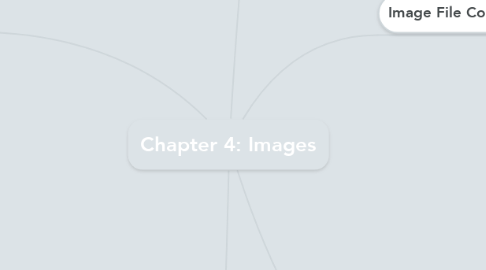
1. Texture
1.1. 3-D drawing and rendering
1.1.1. Features
1.1.1.1. Modeling
1.1.1.1.1. Placing all the elements into 3-D space.
1.1.1.2. Extrusion
1.1.1.2.1. The shape of a plane surface extends some distance
1.1.1.3. Lathing
1.1.1.3.1. A profile of the shape is rotated around a defined axis.
1.1.2. Rendering
1.1.2.1. Use of intricate algorithms to apply user-specified effects
2. Colors and Palettes
2.1. Additive color
2.1.1. In the additive color method, a color is created by combining colored light sources in three primary colors - red, green, and blue (RGB).
2.2. Subtractive color
2.2.1. In the subtractive color method, color is created by combining colored media such as paints or ink.
2.2.2. The colored media absorb (or subtract) some parts of the color spectrum of light and reflect the others back to the eye
2.2.3. The printed page consists of tiny halftone dots of three primary colors: cyan, magenta, and yellow (CMY).
2.3. Dithering
2.3.1. Usually, digitised images are 24 bit, 16 million colour depth.
2.3.2. If display system is limited to less than 16 million colours, the image must be transformed for display in the lesser colour environment (colour dithering).
2.3.3. Dithering is a process whereby the color value of each pixel is changed to the closest matching color value in the target palette
2.3.4. This is done using a mathematical algorithm.
3. Types of Graphic
3.1. Bitmap graphics
3.1.1. Advantages
3.1.1.1. Can have different textures on the drawings; detailed and comprehensive.
3.1.2. Disadvantages
3.1.2.1. Large file size
3.1.2.2. Not easy to make modification to objects/drawings
3.1.2.3. Resizing a bitmapped image requires either duplicating pixels.
3.1.2.4. Graphics become "blocky" when the size is increased
3.2. Vector graphics
3.2.1. Advantages
3.2.1.1. Vector images use less memory space.
3.2.1.2. For the Web, pages that use vector graphics in plug-ins download faster and, when used for animation, draw faster than bitmaps.
3.2.1.3. Vector objects are easily scalable without loss of resolution or image quality.
3.2.1.4. Easy to edit the drawings as each object is independent of the other.
3.2.2. Disadvantages
3.2.2.1. Objects/drawings cannot have texture.
3.2.2.2. cannot be used for photorealistic images.
4. Image File Types
4.1. Macintosh formats
4.1.1. On the Macintosh, the most commonly used format is PICT.
4.1.2. PICT is a versatile format developed by Apple
4.2. Windows formats
4.2.1. The most commonly used image file format on Windows is DIB, also known as BMP.
4.3. Cross-platform formats
4.3.1. JPEG, GIF, and PNG – Most commonly used format on the Web
4.4. JPEG(Joint Photographic Expert Group )
4.4.1. JPEG(Joint Photographic Expert Group )
4.4.2. Lossy compression technique: Losses some image information.
4.4.3. Support a maximum of 16.7 million colors
4.4.4. Degradation of image possible with repeated editing and saving
4.4.5. No transparency
4.4.6. No animation
4.5. GIF
4.5.1. 8-bit per pixel, bitmap image format commonly used by the world wide web
4.5.2. Uses lossless compression technique.
4.5.3. Image can have transparent portion.
4.5.4. Animation possible.
4.6. PNG (Portable Network Graphic )
4.6.1. Supports more than 16.7 million colors
4.6.2. Use Lossless Compression Technique
4.6.3. Image can have transparent portion
4.6.4. No animation
5. Image File Compression
5.1. lossless compression
5.1.1. every single bit of data that was originally in the file remains after the file is uncompressed. All of the information is completely restored
5.2. Lossy compression
5.2.1. reduces a file by permanently eliminating certain information, especially redundant information.

